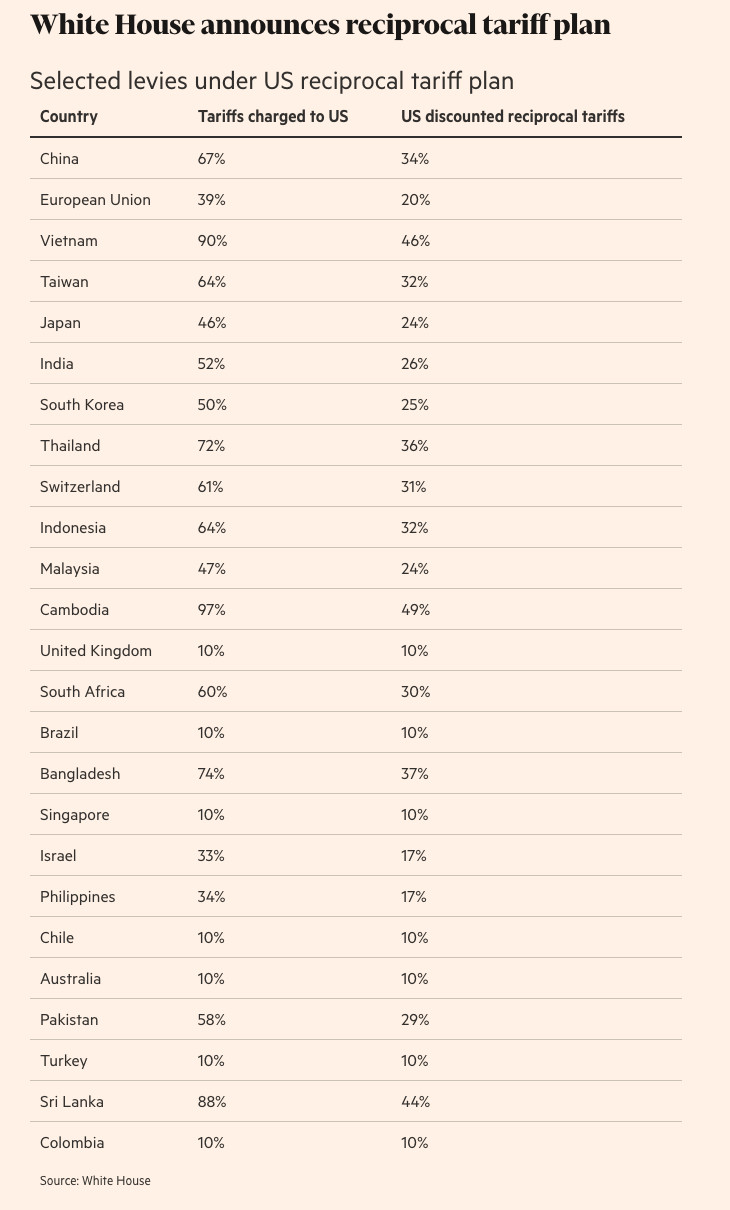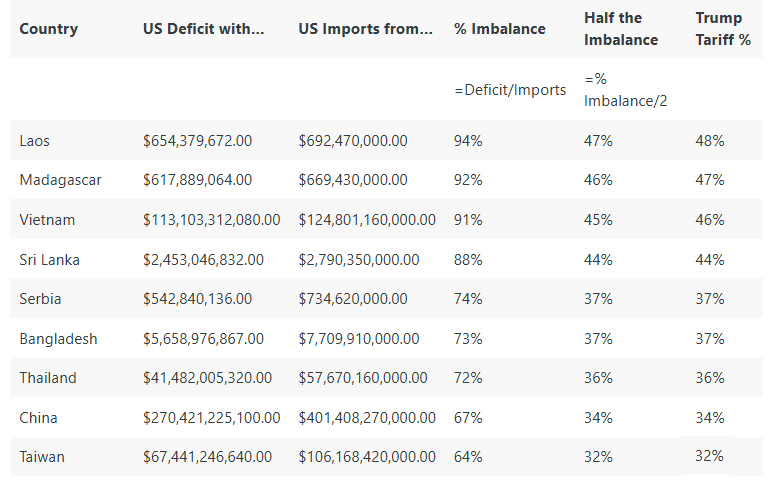The US Dollar and stocks around the world are in a freefall today after US President Donald Trump slapped “reciprocal” tariffs of between 10% and 49% on nearly every country. The economic sense of this decision rests on two main premises. The first is that over the last few decades, manufacturing has migrated from the US to countries with lower labor costs such as China, Vietnam and Thailand. They then sell the finished goods back to US consumers, creating a trade surplus for themselves and a trade deficit for the US. This is largely true and tariffs could be an instrument for fixing this trade imbalance to an extent and protect certain vulnerable domestic industries.
Trade Deficit/Surplus: If country A imports $100 worth of goods from country B, but only exports $40 worth of goods to it, country A has a trade deficit of $60 ($100-$40=$60) with country B, while country B has the same amount of trade surplus with country A.
But the second reason for imposing tariffs, namely that the other countries have ripped the US off by imposing twice as big tariffs on US exports themselves first, is entirely false. Here is the table Donald Trump presented during his “Liberation Day” speech and tariffs announcement on April 2nd.
 Let’s take China as an example. Trump imposed 34% tariffs on goods coming from China as an answer, he claims, to China’s own 67% tariffs on US goods. Presented in this way, it seems only fair that if the Chinese have tariffs in place, then the US has the right to tax Chinese exports, as well. The problem is that China’s tariffs rate on US goods is not 67%, but much lower. So Trump’s 34%, in addition to the previous 20% for 54% in total, is far from reciprocal.
Let’s take China as an example. Trump imposed 34% tariffs on goods coming from China as an answer, he claims, to China’s own 67% tariffs on US goods. Presented in this way, it seems only fair that if the Chinese have tariffs in place, then the US has the right to tax Chinese exports, as well. The problem is that China’s tariffs rate on US goods is not 67%, but much lower. So Trump’s 34%, in addition to the previous 20% for 54% in total, is far from reciprocal.Where do these 67% come from then? Surely Trump didn’t make them up, did he? No, he didn’t, but the 67% in China’s case have nothing to do with tariffs. It is actually the trade deficit the US has with China, expressed as a percentage. See, the dollar value of China’s exports to the US is roughly three times higher the United States’ exports to China, $401B against $131B last year alone. That’s a $270B trade deficit for the US with China in 2024. It is also 67% of the $401B imported. This is where the 67% in Trump’s chart comes from. It is the US’ trade deficit with China, not China’s tariffs rate on US goods. Divided by two, gives the 34% tariffs Trump slapped on China. The same formula has been applied to nearly every country to arrive at its respective tariff rate.
 The US trade deficit with Vietnam is 91% of the total imported. Divided by two gives the 46% tariffs Trump just imposed on the country. US imports from Taiwan exceed its exports to it by 64%, hence the 32% tariffs on Taiwan. It is the same for every other country, where the tariffs rate is different from 10%. But it is not half of what other countries tax US exports, because they mostly don’t. It is half of the US’ trade deficit with them, expressed as a percentage, which is an entirely different thing.
The US trade deficit with Vietnam is 91% of the total imported. Divided by two gives the 46% tariffs Trump just imposed on the country. US imports from Taiwan exceed its exports to it by 64%, hence the 32% tariffs on Taiwan. It is the same for every other country, where the tariffs rate is different from 10%. But it is not half of what other countries tax US exports, because they mostly don’t. It is half of the US’ trade deficit with them, expressed as a percentage, which is an entirely different thing.The United States is the biggest economy with one of the highest living standards in the world. Of course its people will import and consume more from other countries than they do from it. Nobody forced US businesses to move their factories offshore, nor did anyone force American consumers to buy all those foreign goods. It just made economic sense to do it, because it was cheaper. Now, it is about to become a lot less cheaper going forward, since tariffs are an import tax paid by the importers, who then raise their prices in order to protect their profit margins and transfer this cost to the end consumer. Inflation is about to make a comeback and we doubt that this is what our American friends voted for in November…
Which stock should you buy in your very next trade?
With valuations skyrocketing in 2024, many investors are uneasy putting more money into stocks. Unsure where to invest next? Get access to our proven portfolios and discover high-potential opportunities.
In 2024 alone, ProPicks AI identified 2 stocks that surged over 150%, 4 additional stocks that leaped over 30%, and 3 more that climbed over 25%. That's an impressive track record.
With portfolios tailored for Dow stocks, S&P stocks, Tech stocks, and Mid Cap stocks, you can explore various wealth-building strategies.


